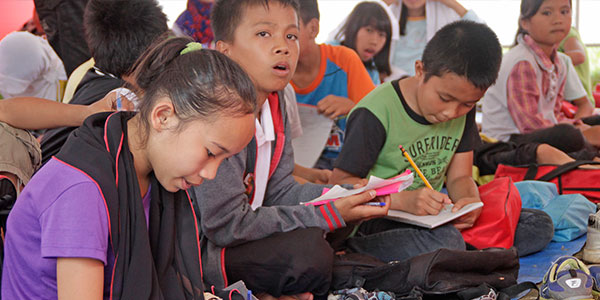
By CAROLYN O. ARGUILLAS
of Mindanews
PANTAR, Lanao del Norte–At the Pantar Central Elementary School here, one can easily tell who among the children are regular students and who are the displaced learners or the evacuee students from Marawi City.
The former proceed to classrooms equipped with chairs, desks and a blackboard, some with shoe racks outside the door. The latter go to their tent classrooms, sit on tarpaulin mats and pray it will not rain or the tent will be flooded.
Four tents have been installed in the school compound, fronting the classrooms for regular students: two from Unicef and two from Save the Children.
Except for Grade 6 students who get to sit on yellow plastic chairs and share three tables borrowed from the principal’s office, evacuees from kindergarten to 5th grade sit or sometimes lie prone on the tarpaulin that doubles as the students’ “desk.”
Sixth graders do not share their tent classroom with another grade level. The rest do: Kinder and Grade 1 together inside the white Unicef tent classroom; Grades 2 and 3 in another; Grades 4 and 5 in a Save the Children tent, Grade 6 in the other.
The school has 881 regular students and 644 evacuees.
“And counting,” said teacher Jahara Macaraya. “Every day, we accept enrollees.”
Macaraya said five more evacuees enrolled, bringing to 644 the number of students who moved there from Marawi.
Pantar is the last town in Lanao del Norte at the boundary with Saguiaran, Lanao del Sur. Marawi City is after Saguiaran town.
Aside from lack of chairs, desks, blackboards are also a problem. Only Grade 6 and combination classes Grades 4 and 5, have borrowed blackboards.
Teachers of the other combination classes hope they can have blackboards and chalks.
Teacher Norhata Serad, a resident of Barangay Banggolo in Marawi City and herself an evacuee showed a Manila paper containing her lecture. “Walang blackboard.”
The tents get flooded when it rains and it has been raining heavily in the area for days now.
Serad said sometimes they can’t hold classes when it rains heavily in the evening.
Add to these problems the fact that tent classrooms are warm and the evacuees are used to Marawi’s cool weather.
The students from Marawi reside temporarily in an evacuation center just outside the school, at the covered court and madrasah or with relatives nearby. A tent city is being set up on a lot across the highway.
Public school teachers displaced by the fighting in Marawi are supposed to report to work by teaching in the evacuation centers near them. But not everyone has reported to work. There were supposed to be 11 teachers from Marawi who would teach in the school, but only around five have reported for work.
As of July 11, the Department of Social Welfare and Development reported 101,086 families or 471,411 persons have been displaced by the armed conflict in Marawi City, from all 96 barangays of the city and from 20 other municipalities of Lanao del Sur, and Kolambungan and Sultan Naga Dimaporo/ Karomatan in Lanao del Norte.
Eighty-seven evacuation centers are still open, housing 4,278 families or 23,380 persons. The rest are home-based or those living with their relativs.
A total of 22,222 children were enrolled in public elementary, high school and senior high school in schoolyear 2016-2017, records from the Department of Education’s Marawi Division showed.
Before the clashes between government forces and the Maute Group began on May 23, the Division’s records show the city had 73 public schools and 45 private schools.
Of the 73 public schools in Marawi City, records show 61 are elementary schools, eight are secondary schools and four are senior high schools.
How many of these schools have been destroyed during the fighting or by aerial bombing can be determined only when the areas have been cleared.
The Deped-Marawi Division has been tracking down where the Marawi students have gone. Some have been tracked down in neighboring towns in Lanao del Sur and Lanao del Norte as well as neighboring Misamis Oriental, but others have been monitored to be in other parts of Mindanao, Visayas and Luzon.
Disclaimer
Mindanao Gold Star Daily holds the copyrights of all articles and photos in perpetuity. Any unauthorized reproduction in any platform, electronic and hardcopy, shall be liable for copyright infringement under the Intellectual Property Rights Law of the Philippines.






